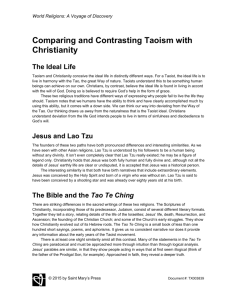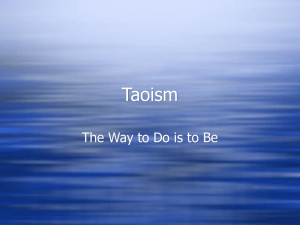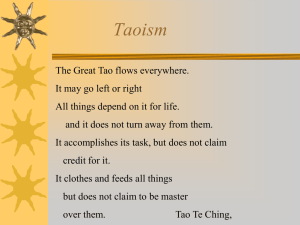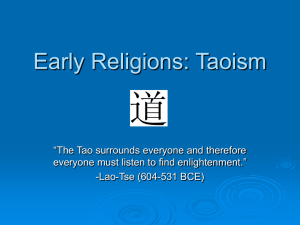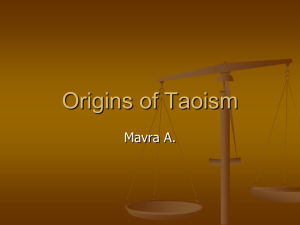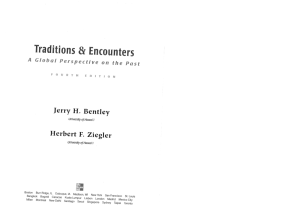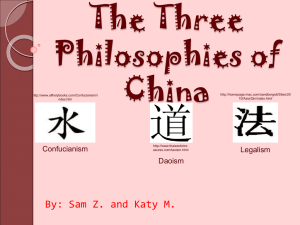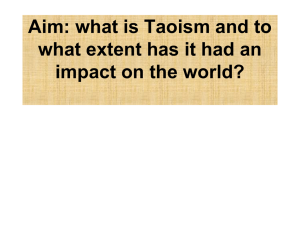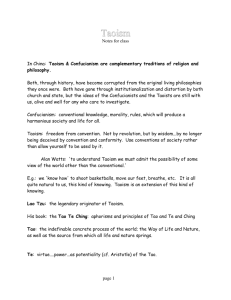2013 Chinese Philosophies and Religions
advertisement
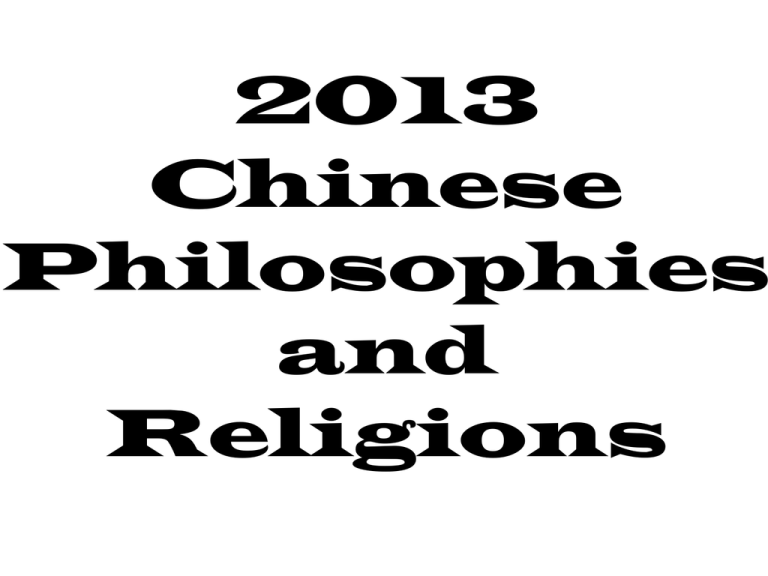
2013 Chinese Philosophies and Religions What is philosophy? • Literally: a love for wisdom • Typically asks Questions like: –What is the purpose of life? –What is a good person like? –What is success? –What is truth? What is knowledge? –How should I act in a situation? • Often philosophy and religion overlap Why did these philosophies develop? • War and social changes were disrupting everyday life • Government lacked control • These philosophies helped guide people and the government to a better life Religion In China • The religious history of China is complex, and has evolved over the centuries. • Deeply interwoven into their beliefs is the worship of their ancestors. • The Chinese believed that the spirits of their ancestors were watching over them, and that they could be called upon during difficult times. Chinese Folk Religion • Belief in spirits • Reverence for ancestors • Priests perform blessing rituals: – purifying space – Exorcising evil spirits (“hungry ghosts”) • Astrology • Divination Chinese metaphysics is about… • • • • • Energy Change Balance Harmony Inter-relationships Chinese Metaphysics Movement of cosmic energies: Rising Falling Expanding Contracting Rotating Represented by and expressed in the “five elements” of nature… The “Five Elements” Productive cycle Fire Wood Water Earth Metal Chinese Metaphysics Concepts • Chi – life force, life energy (“ultimate”) • Yin-Yang – harmony of opposites – Yin = passive state of energy – Yang = active state of energy Tao [ – the “way” of the cosmos, of nature Heaven (t’ien) and Earth “Mandate of Heaven” Practical applications: I-Ching and Feng Shui The I-Ching “Book of Changes” • Ancient divination technique (at least 3000 years old) • Intended to guide humans in decision making • Based on combinations of lines representing the ever changing relationship between passive (yin) and active (yang) energy flow of heaven, human, and earth = yin = yang The Tri-grams Eight combinations of three lines each: heaven wind / wood lake Fire water thunder mountain earth Using the I-Ching Tool • Symbolism of the lines: – – – Upper line = energy state of heaven Middle line = energy state of human Lower line = energy state of earth #31 • Two sets of trigrams are divined to create a hexagram • Use coins or sticks to divine one of 64 hexagrams • Use I-Ching text to discern meaning of the hexagram and any additional meaning for “changing lines” (energies on the verge of changing) • A skilled interpreter is needed to apply the generic meaning of the hexagram Feng Shui • The Chinese art of placement (geomancy) • Means “wind water”– symbolically, the constant flow of wind and water that creates constant change in the world also affects us • Uses the five elements and the eight directions of the IChing as the Bagua tool • Seeks to maintain constant and balanced flow of energies (chi) in a space for improved flow of energy in the people who use the space History of Chinese Philosophies The History of Chinese Philosophy • The Classical Age (6th century BC-2d century AD) – – – – – – Confucianism (Confucius, 551-479 BC) Daoism (Lao Tzu, 6th century BC) Mohism (Mo Tzu, 468-376 BC) The Yin-Yang School (founder unknown) The School of Names (Logic) (Hui Shih, c. 380-305 BC) Legalism (Han Fei Tzu, d. 23 BC) • The Medieval Age (2d-10th centuries BC): relations & conflicts between Confucianism, Daoism, & Buddhism • The Modern Age (11th century AD-Present) – Neo-Confucianism (incorporation of Daoist & Buddhist elements in an overall Confucian perspective) (Chu Hsi, 1130-1200 AD & many others) – 20th century impact of Western philosophies such as Pragmatism & Marxism How is a man to live in a world dominated by chaos, suffering, and absurdity?? Confucianism --> Moral order in society. Legalism --> Rule by harsh law & order. Daoism --> Freedom for individuals and less govt. to avoid uniformity and conformity. Origins of the Mandate • During the Shang dynasty (20001027 B.C.E.) the concept of “Tian” was created • Meaning: sky, heavens, god, the cosmos – idea of heaven – governed all creation – guided moral order 天 Origins of the Mandate • Zhou dynasty (1120-221 B.C.E.) concept of “tian ming” • Mandate of Heaven – explains conquest and submission of falling dynasties – Divinely inspired process – Anyone could assume the right to rule – Tian, or Heaven, chose who would rule the people The Mandate of Heaven is based on four principles: • The right to rule is granted by Heaven – Which gives the ruler prestige and religious importance. • There is only one Heaven – Therefore there can be only one ruler. • The right to rule is based on the virtue of the ruler – Which serves as a check on the ruler's power. • The right to rule is not limited to one dynasty – Which justifies rebellion as long as the rebellion is successful. Origins of the Mandate • A dynasty maintained rule as long as they: – ruled with benevolence and justice – duties of the ruler were carried out correctly • Failure meant the Tian could choose a new ruling family – could not be selfish, cruel, or oppressive Dynastic Cycle • Represents a dynasty’s rise and fall • Cycle starts with winning the Mandate (approval) of heaven • Period of prosperity, marked by motivated and capable emperors • Apex (peak) marked by political, economic, and cultural flowering. Dynastic Cycle • Then the decline began, usually slow (sometimes quite rapid): marked by administrative corruption, repressive laws, and incapable and lazy emperors. • Dynasty would face rebellion and disunity, the loss of peoples’ support, and loss of Mandate The Dynastic Cycle Peak of Dynasty Decline of Dynasty New Ruler Achieves Prosperity Rebellion and Disunity Winner of the Rebellion Wins The Mandate of Heaven Loss of The Mandate of Heaven In Summary The dynastic cycle appears as follows: 1. 2. 3. 4. A new ruler unites China, founds a new dynasty, and gains the Mandate of Heaven China, under the new dynasty, achieves prosperity. The population increases Corruption becomes rampant in the imperial court, and the empire begins to enter decline and instability. 5. A natural disaster wipes out farm land. The disaster normally would not have been a problem; however, together with the corruption and overpopulation it causes famine. 6. The famine causes the population to rebel and starts a civil war. 7. The ruler loses the Mandate of Heaven. 8. The population decreases because of the violence. 9. China goes through a warring states period. 10. One state emerges victorious. 11. The state starts a new empire. 12. The empire gains the Mandate of Heaven. – (The cycle repeats itself.) • Kennedy, Bruce. "Chinese Dynastic Cycle." Killer Roos. 17 February 2008 Key Chinese Dynasties A terra cotta officer from the Qin Dynasty (221-206 BCE) Emperor Taizong - Tang Dynasty Xia Shang 2070-1600 BCE 1600-1046 BCE 470 years 554 years Zhou West 1046-771 BCE East 770-256 275 years 514 years Tang 618-907 AD 289 years Song North 960-1127 AD South 1127-1279 AD 167 years 152 years Ming 1368-1644 AD 276 years Qing 1644-1911 AD 268 years Taoism or Daoism Feminine Passive Darkness Cold Weak Earth; Moon Masculine Active Light Warmth Strong Heaven; Sun Laozi’s Daoism Yang Yin “What Is” “What Is Not” Light Dark Masculine Feminine Creative Receptive Active Non-action Heaven Earth Life Death Yin and Yang • Negative and positive principles of the universe. • One cannot exist without the other • Each is incorporated into the other • Not Opposites, but Complements – Complete each other Philosophy Goal Daoism Founder: Laozi Simple and natural living. How Achieved Influence Happiness and peace were gained by living in harmony with nature. Rulers were encouraged to rule less harshly. Influenced Chinese thought, writing and art. Daoism developed into a popular religion. Belief Systems (not religions) • Daoism (Taoism) – Universe is in constant flux – Many rituals meant to promote harmony – People should take the world as they find it – Concern about power or wealth is irrelevant, instead you should seek balance/harmony with your place in nature (Yin/Yang) • Allowed to continue by dynasties because of its emphasis on spirituality not secular matters – Popular with people who were interested in a more spiritual or religious philosophy Lao Tzu – founder of Daoism Rise of Chinese Philosophies Daoism • Founder: – Laozi • Ideas About Order & Harmony: – Understanding nature is key to order & harmony – Natural Order more important than Social Order • Ideas About A Universal Force: – Universal Force called Dao (aka “The Way”) guides all things Daoism • Like Confucius, the philosopher Lao Zi studied human society. • He, too, searched for ways to establish an orderly society. • Lao Zi, the founder of Daoism, however emphasized the link between people and nature rather than the importance of proper behavior. • Scholars know little about Lao Zi, but that his thoughts are contained in the book The Way of Virtue. Daoism • A contemporary of Confucius was a teacher named Laozi. Most of what we know about Laozi is so heavily mixed with legend, that it is difficult to know what is true, and what is myth. Not sure when he died. [604 B.C.E. - ?] His name means “Old Master” Was he Confucius’ teacher? Taoism The father of Taoism • Lao Tzu: –Was born around 640 B.C. –No one is really sure about any dates or places. Taoism • Lao Tzu was not pleased with his people, so he left and went on a journey. – Lao Tzu was asked to leave a record of his beliefs with his civilization. – It took him three days to complete 5000 characters titled the Tao Te Ching. Taoism • The Tao Te Ching is in effect the Taoist bible. – It centers around the concept of Tao. Or the “path” Taoism • There are three meanings of “Tao” – Tao- The way to ultimate reality. This Tao is way to vast for a person to comprehend or fathom. – Tao- The way of the universe. The norm, the rhythm, and the driving power in all of nature. Deals more with the spiritual side then the Physical side of things. Taoism • There are three meanings of “Tao” – Tao- The way of human life. It refers to the way that we mesh with the Tao of the universe. Taoism • Just like the three meanings of Tao. All three were designed to facilitate the power of Tao through “te” • There are three types of Taoism: – Philosophical Taoism – Religious or Popular Taoism – Vitalizing Taoism Taoism • Philosophical Taoism: – Is a reflective look at life – Relatively unorganized – Teaches what you should understand – You work on improving yourself – Seeks power through knowledge – Sought to conserve “te” and not to expend is on friction and conflict. – Associated Lao Tzu, Chuang Tzu, and Tao Te Ching Taoism • Philosophical Taoism: – Wu Wei- The perfect way to live life, and reduce conflict and friction • Combines supreme activity and supreme relaxation The conscious mind has to get out of the way of its own light. For one to perfect the wu wei lifestyle. A lifestyle above excess and tension. As in Buddhism Taoism • Religious Taoism: – Became a full fledge church – Its programs are active – “The Taoist priesthood made cosmic life-power available for ordinary villagers.” – Their power was with magic, the harnessed higher powers for human ends. – Want to help transmit “Ch’i” to people that can not get it on their own. As in Buddhism Taoism • Vitalizing Taoism: – The programs are active – Relatively unorganized – Teaches what you should do. – Is a self help program – You work on improving yourself – Want to increase the amounts of Tao or “te” in their life – They do this through “ch’i” • For centuries, Chinese artists have depicted Lao Zi as a kindly sage who embodies the ideal heart of Daoism. • Lao Zi advised: “Reveal thy simple self, embrace thy original nature, check thy selfishness, curtail thy desires.” Taoism • Vitalizing Taoism: –They want to remove the barriers that slowed the flow of “ch’i” –The power of “ch’i” • “could shift Heaven and Earth” Taoism • Philosophical, Religious and Vitalizing Taoism • All center on how to maximize their Tao. • They honor hunchbacks, cripples. Because the tallest tree get the axe first. • Their temples blend in with the landscape. They do not stand out. Unlike Buddhism and Confucianism Taoism • Philosophical, Religious and Vitalizing Taoism – They all teach that people will be at their best, when they are living in harmony with their surroundings. – They consider ceremonies pompous and downright silly. – They feel there is nothing to gain from punctiliousness, and the meticulous Unlike Confucianism observance of propriety. Unlike Buddhism Reject Material Things • Laozi taught that a force known as the Dao permeated all living things. • He told his followers that the most important thing an individual could do is to reject the world, and their desires for worldly possessions and power, and commune with nature, bringing ones self into a state of oneness with the Dao. Relate to Nature • Many individuals in China practices both Confucianism and Daoism. • Confucianism taught them how to behave towards one another, while Daoism taught them how to behave towards the natural world, and with themselves personally. Daoism / Taoism • Founder – Laozi (Lao-Tze) • Sacred Text –Tao-te-Ching – Lao-Tze - The Book of the Way • Major Teachings – Live in harmony with nature – Be like water: • Water goes with the ‘flow’ • but is unstoppable • Implications for Government – Government unnatural • Tries to change too much • Usually makes things worse Taoism The Way of Harmony with Nature • A philosophy – Profound and paradoxical • A way of life – Playful and practical • A religion • Originating in 6th century BCE China Nature knows best The Natural Way • Daoists believed that the best way to live was the natural way. • In Chinese the word dao means “the way.” Daoists did not define “the way,” however. • It is said, “Those who know the Dao do not speak of it; those who speak of it do not know it.” • To Daoists, Confucian rules for society were useless. • A society with rules was an artificial creation that disturbed the natural order. • Daoists believed people should do nothing that was contrary to nature. “The duck’s legs are short, but if we try to lengthen them, the duck will feel pain. The crane’s legs are long, but if we try to shorten them, that crane will feel grief. Therefore we are not to cut off what is by nature long, nor to lengthen what is by nature short.” Daoism The “Way” is recast in light of the fact that the way of humanity had been lost (the warring states period) The traditional tri-part dao is redefined as the way of earth (kun), the way of heaven (tian), and the Way (if it must be named) 1. Dao [Tao] is the first-cause of the universe. It is a force that flows through all life. 2. A believer’s goal is to become one with Dao; one with nature. [“The butterfly or the man?” story.] 3. Wu wei --> “Let nature take its course.” --> “The art of doing nothing.” --> “Go with the flow!” 4. Man is unhappy because he lives acc. to man-made laws, customs, & traditions that are contrary to the ways of nature. Daodejing: “The Way and It’s Power” by Laozi Dao: the ineffable way of life, pattern of the world, source of all that is (and is not); from the one came the two (yin - yang) and from the two came… the 10,000 things (wan or “everything”) De: the power, potency, or “virtue” of dao; reflected in action so excellent, balanced, and harmonious that it seems to be “no action” at all Wuwei: actionless activity or non-ado Dao Wuwei De To escape the “social, political, & cultural traps” of life, one must escape by: 1. Rejecting formal knowledge and learning. 2. Relying on the senses and instincts. 3. Discovering the nature and “rhythm” of the universe. 4. Ignoring political and social laws. Philosophical Taoism • The Tao (“path” or “way”) – – – – The “nameless” The “Mother of ten=thousand things” The “uncarved block” All pervading within and beyond nature • Te (“power” or “virtue”) – One’s natural ability brought to peak potential through following the way • The Taoist Sage: learns from observing the way of nature (flowing water, wind) and letting nature guide his way through life Laozi and The Way of Nature Laozi used nature as the model of this way of beauty, grace, balance, and ultimately complete “metaphysical” harmony Dao or “what is not” gave birth to “what is” in the form of nature and the primal forces that transform it And back to dao all that it creates will return (as a natural part of this process) Daoism / Taoism • Tao: ultimate reality behind existence • Man must conform to nature – But not to society • Confucian & Legalist social, economic, and political thinking: – Masculine, hard, managing, aggressive, rational, and commanding • Daoists are different. – balancing masculine with feminine – Be yielding, permissive, withdrawing, mystical, and receptive Three Jewels of Taosim • Compassion - leads to courage • Moderation - leads to generosity • Humility - leads to leadership Lao Zi on Government • Lao Zi believed that the best government was the one that had the fewest rules and laws. • He valued simplicity. Lao said: “The wise man keeps to the deed that consists in taking no action and practices the teaching that uses no words.” Bad Government According to Daoists Daoist influence and inventions • The Daoists study of nature enabled them to make advances in science and technology. • They recorded the movements of planets and increased their knowledge of astronomy. • They may have developed the magnetic compass to determine favorable places for graves. • Daoist observations of natural forces led to discoveries in chemistry and biology. • Some scholars think that Daoists invented gunpowder, which they used to frighten ghosts. More Taoist Concepts • Wei-wu-wei (“active non-action”) – Passive non-resistance to the natural forces of life – Natural way to get things done with least effort and greatest success – “Go with the flow,” yield to the natural way of things – Applied in all walks of life • Relativity: “good” and “bad” as a matter of perspective – The Taoist sage is non-judgmental Taoism as a Way of Living • Seeking Health and Longevity: through diet, meditation, exercise, and a stress-free life • Alchemy: seeking the chemical “elixir of life”to achieve immortality • Meditation: “Inner Alchemy Meditation” – seeking spiritual rather than chemical transformation • Natural/holistic healing: herbal medicine, acupressure, acupuncture, exercise… • T’ai-Chi-Ch’uan (“grand ultimate boxing”) – A slow, graceful martial art stressing movement in balance Some other Yin Images from the Daodejing Mother or Mysterious Feminine Infant Uncarved Block or Raw Silk Water Breath, Vapor, or “Vital Energy” (qi) Tailor, Warrior, Charioteer… does little cutting, fighting, and does not rush ahead, respectively Taoism Origins and Texts • Legendary founder: Lao Tzu (6th century BCE) • Primary text: Tao Te Ching (the “Book of the Way and the Power”) – 81 short “chapters” containing the basic philosophy of living in harmony and balance • Chuang Tzu (4th century BCE) – Author of companion text: The Chuang Tzu – Collection of stories exemplifying the wisdom and nature of the Taoist sage Daoists and Religion • Daoism developed links with folk religions. • Peasants believed that gods and spirits controlled the unseen powerful forces in nature. • To find out what would please the spirits, they turned to Daoist priests for help. • Priests used all kinds of magic to determine lucky days for weddings and the best place for graves. Religious Taoism • Deification of Lao Tzu • The Jade Emperor and the eight “Immortals” • Taoist temples with images of Lao Tzu and other “immortals” • Taoist Priests combine Taoist meditation with purification rites of folk religion exorcism practices • Taoist sects develop beginning in 1st century, additional teachers and texts Daoist Influence on China • Architecture – Buildings pursues the harmonious unity of humans and nature. Daoists skillfuly built temples that conform to the contours of the land. – Buildings reflect traditional forms and values. – Buildings reflect values of openness, fulfillment, and long life. – Contain symbols and motifs that represent many traditional Chinese folk values. Taoism vs. Confucianism • Confucianism – A system of thought representing “conventional values” – social-minded – represents a higher form of moralism – optimistic rationalism – Humanism: humaneness (ren) and righteousness (yi) – family ethics – ritualization of life ‘Tao of Pooh’ Taoist Philosophy From The House at Pooh Corner A clever “Rabbit’s clever,” said Pooh thoughtfully. mind is not a “Yes,” said Piglet. “Rabbit’s clever.” heart. “And he has Brain.” “Yes,” said Piglet, “Rabbit has Brain.” There was a long silence. “I suppose,” said Pooh, “that that’s why he never understands anything.” The wise know their limitations; the foolish do not. Roo and Tigger were walking along the forest one morning, and Tigger was talking about all the things Tiggers can do… “I can swim,” said Roo. “I fell into the river, and I swimmed. Can Tiggers swim?” “Of course they can. Tiggers can do everything.” “Can they climb trees better than Pooh?” asked Roo, stopping under the tallest Pine Tree, and looking up. “Climbing trees is what they do best,” said Tigger. “Much better than Poohs.” And the next thing they knew, they were stuck in the tallest pine tree.
